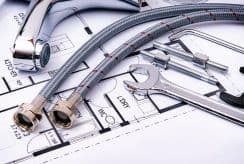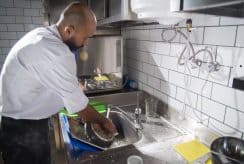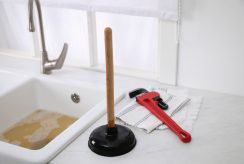In an environmentally conscious world, sustainable building practices are gaining popularity and importance. Epoxy flooring is a great choice for homeowners and businesses seeking a sustainable solution to renovate their space.
Epoxy floors are low-VOC, which minimizes the release of harmful chemicals during and after installation. Their reflective surface can also reduce the need for artificial lighting, reducing electricity usage and associated carbon emissions.
1. Environmentally Friendly
Epoxy flooring has long been a practical and hard-wearing surface solution, but it can also be an environmentally friendly choice. Traditional commercial and residential floor materials like vinyl and carpet take hundreds of years to decompose in landfills, but epoxy floors can be recycled when they reach the end of their lifespan. The manufacturing process of epoxy coatings also uses significantly less energy than traditional flooring materials, reducing carbon emissions and helping the environment.
In addition, many epoxy products are formulated with a lower level of volatile organic compounds (VOCs) than traditional flooring solutions. This makes the material safer for indoor air quality, reducing respiratory issues and promoting a healthier workplace or living space. VOCs are emitted by a wide range of household and office products, including cleansers and disinfectants, paint and paint strippers, varnishes, wood preservatives, air fresheners, adhesives, permanent markers, and more. These toxins can contribute to sick building syndrome, and in high concentrations can cause serious health problems. Fortunately, many epoxy coating manufacturers have developed low-VOC and even non-toxic products that withstands heavy traffic, chemicals, and wear.
Moreover, epoxy is easy to clean and maintain, eliminating the need for harsh chemicals and solvents that can damage the environment. The reflective nature of the floor coating can also reduce reliance on artificial lighting, saving on utility bills and further reducing environmental impact.
Furthermore, epoxy floor coatings are durable and long-lasting, preventing premature replacement and waste generation. Additionally, precise application techniques minimize material waste, allowing you to get the most out of your epoxy floor.
When it comes time to replace your epoxy floors, you can recycle the old flooring and apply a new coating over the top, eliminating the need for removal and disposal of the existing substrate. This approach to flooring demonstrates that epoxy is a truly sustainable option.
Additionally, some epoxy flooring products can help earn points toward LEED certification. This internationally recognized green building program rewards businesses for their commitment to sustainability, including energy efficiency and the use of sustainable materials. Talk to a Resinous Flooring Supply Southeast representative about the green options available for your business today.
2. Durable

Epoxy flooring is a highly durable surface that resists impact damage, making it ideal for warehouses and other commercial and industrial spaces. Unlike traditional tiles that may need replacement after just a few years, epoxy floors can withstand the constant flow of vehicles, heavy machinery and forklifts in busy facilities.
The non-porous nature of epoxy coating also prevents liquids from penetrating the concrete beneath, which would otherwise corrode and potentially contaminate surrounding materials. This feature is especially beneficial for settings where chemical spills are a concern, such as car dealerships or manufacturing plants.
Because it has a non-porous, seamless surface, epoxy flooring is very easy to clean. Regular sweeping and dust mopping with mild cleaning solutions can keep the floor free of dirt, debris and abrasive particles that can wear down the surface. The smooth epoxy surface is also resistant to chemical damage, minimizing the need for costly repairs or replacements.
Many epoxy products are available in low VOC formulations that reduce volatile organic compound emissions into indoor air. This helps to improve indoor air quality and eliminate harmful VOCs that can irritate the nose, eyes and throat of workers. This is particularly important for areas that will see a lot of foot traffic or vehicle and equipment traffic, as contaminated air can quickly lead to worker fatigue, reduced performance, and even respiratory illness.
During the installation process, water-based epoxy is also safer for the installers and those working nearby than solvent based systems that emit harmful fumes. These chemicals have been linked to sick building syndrome, which can cause a range of health issues, including headaches, fatigue and irritation to the skin, eyes and nose. Choosing low VOC water based “green” epoxy can help to minimize these risks.
At the end of their life cycle, epoxy materials can be repurposed or recycled rather than sent to landfills, which contribute to environmental degradation. The longevity and durability of epoxy floors also means that they need to be replaced less often than other flooring types, reducing waste and energy usage.
The use of recycled materials in some epoxy products further promotes sustainability, allowing businesses to support eco-friendly building practices. Moreover, saving an old pitted or damaged concrete floor by applying an epoxy coating rather than tearing it out and replacing it greatly reduces the need for new materials and resources.
3. Easy to Clean
Epoxy is a durable floor coating that is very easy to clean. With regular sweeping and mopping, the majority of dirt, dust, and debris is easily removed. This minimizes build-up and stains, as well as prevents more serious damage from occurring that may require professional deep cleaning or repair.
Unlike carpet, epoxy floors are not an incubator for bacteria or fungus. However, this does not mean that your floors do not need frequent cleaning. In fact, areas that are often wet, such as pool decks and public bathrooms or shower stalls should be cleaned frequently to avoid bacterial growth and mold or fungus. These areas need to be sanitized to protect the health of your staff and customers/clients.
In order to keep your epoxy floors clean and hygienic, choose a cleaner that is non-alkaline and contains no solvents. Water, mild soap, or even vinegar mixed with warm water will usually do the trick. This will not only remove the dirt, but it will also help to protect your epoxy floors from damage caused by harsh chemicals that can strip or etch the surface.
If you need a stronger cleanser, opt for an organic solution such as a sugar soap or citrus based cleaner. These are typically less damaging to your flooring than chemical-based solutions, and will still leave your floor looking clean.
To reduce the amount of dirt and grime that needs to be removed from your epoxy floors, make sure to install walk-off mats at all entrances to your building. This will trap the majority of the dirt and grit before it is able to sink into the epoxy surface and scuff it. It’s a good idea to vacuum and sweep the mats regularly as well, to ensure that you are always removing as much grit and dirt from your floors as possible.
For areas that are difficult to vacuum or sweep, or for a more thorough clean, a light scrub is sometimes needed. When this is the case, it’s a good idea to hire a professional. It is important that your flooring be properly prepped and recoated prior to this process, so it is best left to professionals that understand the ins and outs of proper preparation, application, and curing.
4. Affordable
Epoxy is a versatile and durable flooring material that has a low cost compared to many other floor coatings. It can withstand acidic chemicals, is installed without seams and can be colored or textured to match almost any specification. It holds up to heavy foot traffic and with additives can even hold the weight of airplanes or large machinery without cracking. It also has the added benefit of being a seamless surface, which makes it easier to clean and reduces the likelihood of damage that requires repairs and replacement.
Low VOC Emissions
Because epoxy is a solvent-free formulation, it emits lower volatile organic compounds than traditional flooring materials, which leads to reduced indoor air pollution. This is especially important for commercial spaces where occupants spend a majority of their time indoors.
Durability and Longevity
Epoxy floors are made from recycled materials, which help to minimize depletion of natural resources. Additionally, because they resist wear and tear over time, they require less maintenance and replacement, further contributing to sustainability.
The Durability of Epoxy Floors Can Be Enhanced with Decorative Flakes
Adding decorative flakes to the epoxy during pouring adds color, texture and visual interest. These flakes come in a variety of colors and blends and can range from translucent to metallic. They are typically hand-spread into the wet epoxy after mixing and can be used in light to heavy amounts depending on the look you want. A clear coat will also be applied to the floor, which helps to maintain its appearance and extends the lifespan of the floor.
A professional contractor will use a high-quality, non-toxic, 100% solids epoxy product. This eliminates the need for a solvent or water, which reduces VOC emissions and ensures that the epoxy will stand up to heat, chemical damage and physical injury like gouges or scratches. It will also be odor-free and won’t need to be reapplied for over 20 years.
A professional will take several factors into consideration when quoting for an epoxy installation. Be wary of a contractor who gives you a very low quote. They may be skipping essential floor preparation or rushing the job to keep costs down, which can affect the quality of the finished product and its longevity. They may also be using a subcontractor who isn’t properly trained or certified in the application process.





